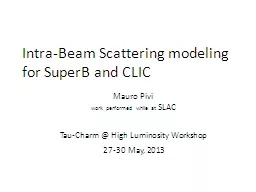/


SuperB and CLIC Mauro Pivi work performed while at SLAC TauCharm High Luminosity Workshop 2730 May 2013 ID: 812047
Download The PPT/PDF document "Intra-Beam Scattering modeling for" is the property of its rightful owner. Permission is granted to download and print the materials on this web site for personal, non-commercial use only, and to display it on your personal computer provided you do not modify the materials and that you retain all copyright notices contained in the materials. By downloading content from our website, you accept the terms of this agreement.
Slide1
Intra-Beam Scattering modeling for SuperB and CLIC
Mauro
Pivi
work performed while at
SLAC
Tau-Charm @ High Luminosity Workshop
27-30 May, 2013
Slide2Analytical IBS in SuperB
LER (lattice V12)
Effect is reasonably small. Nonetheless, there are some interesting questions to answer:
What will be the impact of IBS during the damping process?Could IBS affect the beam distribution, perhaps generating tails?
h
=2.412 nm
@N=6.5e10
v=5.812 pm@N=6.5e10
z=4.97 mm@N=6.5e10
Theo
Demma
2012
Slide3Intra-Beam Scattering (IBS) Simulation Algorithm: CMAD
CMAD parallel code:
C
ollective effects & MADLattice read from MADX files containing Twiss functions and transport matricesAt each element in the ring, the IBS scattering routine is called. At each element:
Particles
of the beam are grouped in cells.Particles inside a cell are coupled
Momentum of particles is changed
because of scattering.Particles are transported to the next element.Radiation damping and excitation effects are evaluated at each turn. Vertical dispersion is included Code: Electron Cloud + IBS + Radiation Damping & Quantum Excitation
IBS applied at each element of the RingM. Pivi, T. Demma (SLAC, LAL), A. Chao (SLAC)27-30 May, 2013
Slide4For two particles colliding with each other, the changes in momentum for particle 1 can be expressed as:
with the equivalent polar angle
eff and the azimuthal angle distributing uniformly in [0; 2], the invariant changes caused by the equivalent random process are the same as that of the IBS in the time interval ts
IBS -
Zenkevich-
Bolshakov Algorithm
Tau-Charm @ high LSIRE code uses similar implementation (A. Vivoli Fermilab, Y. Papaphilippou CERN)27-30 May, 2013
Slide5IBS modeling: animation
http://www-user.slac.stanford.edu/gstewart/movies/particlesimulation_animation/
Slide6IBS evaluation in SuperB
Parameter
Unit
ValueEnergy
GeV
4.18
Bunch population
10106.5
Circumferencem1257
Emittances (H/V)nm/pm1.8/4.5 Bunch Length
mm
3.99
Momentum spread
%
0.0667
Damping times (H/V/L)
ms
40/40/20
N. of macroparticles
-
10
5
N. of grid cells
-
64x64x64
Bane
Piwinski
IBS-
Track
/CMAD
M.
Pivi
, T.
Demma
27-30 May, 2013
- IBS-
Track
- C-MAD
One turn evolution:
compare codes and theory
One turn evolution:
compare codes
Slide7IBS evaluation for CLIC DR
Ideal lattice
CMAD simulations compare with theory
: o
ne turn evolution
of
emittance growth in the CLIC Damping Ring. Energy (GeV)2.86emitx (m)5.554e-11
emity (m) 5.8193 e-13Deltap 1.209209e-3sigmaz (m) 0.001461
Slide8IBS Distribution study
Parameter
c
2799
Confidence
Z
1857.56<1e-6X
1455.68<1e-6Y 778.2280.6920
M. Pivi (SLAC), T. Demma (INFN)
Slide9Previous
work
at CERN: SIRE IBS Distribution studyParameterValueEq. ex (m rad)2.001e-10Eq. ey (m rad
)2.064e-12
Eq. sd
1.992e-3
Eq. sz (m)1.687e-3Parameterc2999
ConfidenceDp/p3048.7<1e-15X1441.7<1e-15Y1466.9<1e-15
A. Vivoli , Y. Papaphilippou CERN
Slide10‘Equivalent’ Long term
Emittance
Evolution in SuperB LER These preliminary simulations are performed using a factor F=10 faster damping time and a factor 10 larger beam intensity
t
x = 10-1
x 40 ms ty = 10-1x 40 ms ts = 10 -1x 20 msFor SuperB V12 LER Nb= 2x10
10 - 12x1010
Slide11e
x
(m)
ez (m) Injection1100e-91.5e-4Extraction w/ IBS25e-93.3e-6Extraction w/o IBS23e-9
2.97e-6
IBS in SuperB
Damping Ring
Evolution
of emittance with radiation damping and IBSJust 1 IP per tun is considered hereBeam injection
with IBSwithout IBS
Slide12IBS evaluation next steps
Code validation: benchmark recent experiments made at
CesrTA
and SLS with simulations Tau-Charm factory estimate gives larger IBS growth than SuperB because of larger beam intensity and lower energyCode predictions: long term beam evolution in Tau-Charm and CLIC Damping RingsIncluded magnet vertical misalignments and vertical dispersionNext: Include magnet rotation and coupling also to closely benchmark experimental data (CesrTA, SLS)
Slide13Summary
Developed multi-particle simulation codes for Intra-beam scattering
Codes in agreement with theoretical models
Estimations for Super-BPlans for methodical evaluation of IBS in Tau-Charm are needed.
Slide14Thanks to:M. Boscolo, M. E. Biagini
, A. Chao